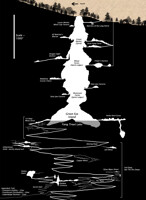
Hanstone Sector, Hex 2927
Insomnia D-410168-9 Lo, Ni 301 NS M0V
Ring, 1 Dia out. Y-000000-0 Ba
Discovered and first mapped by the Iskatel in 2196AD Insomnia is an almost airless barren world circling a main sequence bright red star at 0.2AU. Insomnia has a reddish ring comprised primary of iron particulates. Out-gassing from massive volcanoes can sometimes be witnessed from orbit, but for the most part, the planet is cold and lifeless.
The Directorate Navy maintains a small surface base on Insomnia for emergency landings, as well as a 1000 displacement ton Sentinel class station in orbit, to act as system traffic control and minor repair facility. The system is officially declared a navigational hazard, and ships traversing the Polynesia reach from Onopko or Sutter are encouraged to refuel from the system's sole gas giant, Suena (1AU out from the central star), and continue on their way without tarrying in system.
In 2215, Sentinel 8's station commander, and chief authority in Insomnia is Lt. Commander Layla Berringer, who has held the post for the last seven years. Though the station is only built in 2201, numerous micro meteor impacts, and a docking incident with a 20ton launch in 2207 have added more 'character' and required more maintenance on the station, contracted out of Leeds at Saknussemm, 2 jumps away, than any other Sentinel station to date.
Besides the station crew complement of 32, a planetary Directorate Navy funded geological survey of 27 also live on the Sentinel, though at any given time several of them may be on the planet's surface in one of a half dozen portable bases set up across its surface.
Although no Naval ships are assigned to defend Insomnia, the 1000 ton destroyer, Penetrator visits every other month for a few days in its regional patrols. The 700ton escort, Python likewise spends up to a week in system on a similar time schedule. Other trade and resupply ships can sometimes be encountered, either visiting station or in the process of fuel scooping from the gas giant, but their stays are shorter than at most other Directorate worlds, and slightly less common to encounter.
An attempt at a ringed planet - I've done them before, but I pretty much dislike the using of 'clouds+swirl' effect, which most of the tutorials for ringed planets use, to get my rings. Next time I'll try a circular noise gradient, if I can figure out how to make it work right.
Here, the faintness of the ring - intentional, works in my favor to not show off the 'swirl' arcs and feathers quite so much.
Category All / All
Species Unspecified / Any
Size 1280 x 1100px
File Size 984.1 kB
M05 is a red, 'main sequence', ie, a slightly larger and warmer red dwarf than ... well, all the other red dwarves out there, verging on the orange sequence. Trust me, even at that distance, its not much light/heat at all. The planet's on a fairly slow rotation, but not yet tidally locked. Even without extensive shielding, temporary bases can be put on the dusk meridian and stay manned for months before the slow rotation brings them to dawn side.
As to the rings, they're fairly 'recent' in the system's history - its an old star, and all accretion disks are long since congealed. There's a lot of between the lines I did in the entry above on purpose. Its not really a 'navigational hazard'.
As to the rings, they're fairly 'recent' in the system's history - its an old star, and all accretion disks are long since congealed. There's a lot of between the lines I did in the entry above on purpose. Its not really a 'navigational hazard'.

 FA+
FA+









Comments